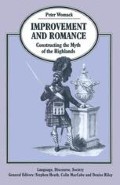Abstract
The Highlands, then, are imaginary. It follows that the non-Highlands (the Scottish Lowlands, or the metropolis, or anglophone Britain generally) are real. The consumer of the myth partakes of ‘the pleasing enthusiasm which these wilds impart’ and then quits them ‘with regret’:1 to move back across the Highland line is to leave Fancy’s Land and re-enter, sadly or thankfully but in either case inevitably, the realm of factual truth.
Access this chapter
Tax calculation will be finalised at checkout
Purchases are for personal use only
Preview
Unable to display preview. Download preview PDF.
Notes and References
The phrases are those of the unnamed lady in Charles Cordiner, Remarkable Ruins, and Romantic Prospects, of North Britain (1795): see above, Chapter 5, note 62.
See, for example, what David Edgar makes of the proposition that ‘on many key issues the British think further to the left than they vote’. Socialist sentiments; capitalist power. David Edgar, ‘Never Too Old: Learning from the Sixties’, New Socialist, no. 38 (May 1986), pp. 16–20.
A. McDonald, Evening Amusements, or, What Happens In Life, A Novel, 2 vols. (Edinburgh, 1797), vol. I, p. 243.
Friedrich Schiller, On the Naive and Sentimental in Literature, translated by Helen Watanabe-O’Kelly (Manchester, 1981), p. 22.
See T. C. Smout, ‘The Landowner and the Planned Village in Scotland 1730–1830’, in N.T. Phillipson and R. Mitchison (eds), Scotland in the Age of Improvement (Edinburgh, 1970), pp. 73–106.
This point is trenchantly made by Ian Carter, ‘Economic Models and the Recent History of the Highlands’, Scottish Studies, vol. 15 (1971), pp. 99–120.
E.g., Ian Grimble, ‘Emigration in the Time of Rob Donn, 1714–1778’, Scottish Studies vol. 7 (1963), pp. 129–53; and Hugh MacDiarmid’s poem ‘A Golden Wine in the Gaidhealtachd’, in The Complete Poems, ed. Michael Grieve and W. R. Aitken, paperback edn, 2 vols. (Harmondsworth, 1985), vol. I, p. 721.
David Stewart of Garth, Sketches of the Character, Manners, and Present State of the Highlanders of Scotland, 2 vols. (Edinburgh, 1822); Osgood Mackenzie, A Hundred Years in the Highlands (1921); Queen Victoria, Leaves from the Journal of our Life in the Highlands (1868).
Explored, for example, in Tom Nairn’s essay ‘The Modern Janus’, in The Break-Up of Britain (1977), pp. 329–63.
Gemeinschaft and Gesellschaft: society-as-community and society-as-state. Title of a book by the German sociologist F. Tönnies (1887). See Raymond Williams, Keywords (1976), p. 66.
The phrase is from Wordsworth’s ‘Address to Kilchurn Castle, Upon Loch Awe’, William Wordsworth, Poetical Works, ed. E. de Selincourt and H. Darbishire, 5 vols. (Oxford, 1940–9), vol. III (1946), p. 78.
Eric Richards, A History of the Highland Clearances, Volume 2: Emigration, Protests, Reasons (1985), pp. 203, 229–30.
E. MacCurdy, A Literary Enigma — The Canadian Boat-Song: its Authorship and Associations (Stirling, 1935), reviews the evidence, as well as giving the text of the poem.
Author information
Authors and Affiliations
Copyright information
© 1989 Peter Womack
About this chapter
Cite this chapter
Womack, P. (1989). The Structure of the Myth. In: Improvement and Romance. Language, Discourse, Society. Palgrave Macmillan, London. https://doi.org/10.1007/978-1-349-08496-8_8
Download citation
DOI: https://doi.org/10.1007/978-1-349-08496-8_8
Publisher Name: Palgrave Macmillan, London
Print ISBN: 978-1-349-08498-2
Online ISBN: 978-1-349-08496-8
eBook Packages: Palgrave Literature & Performing Arts CollectionLiterature, Cultural and Media Studies (R0)

